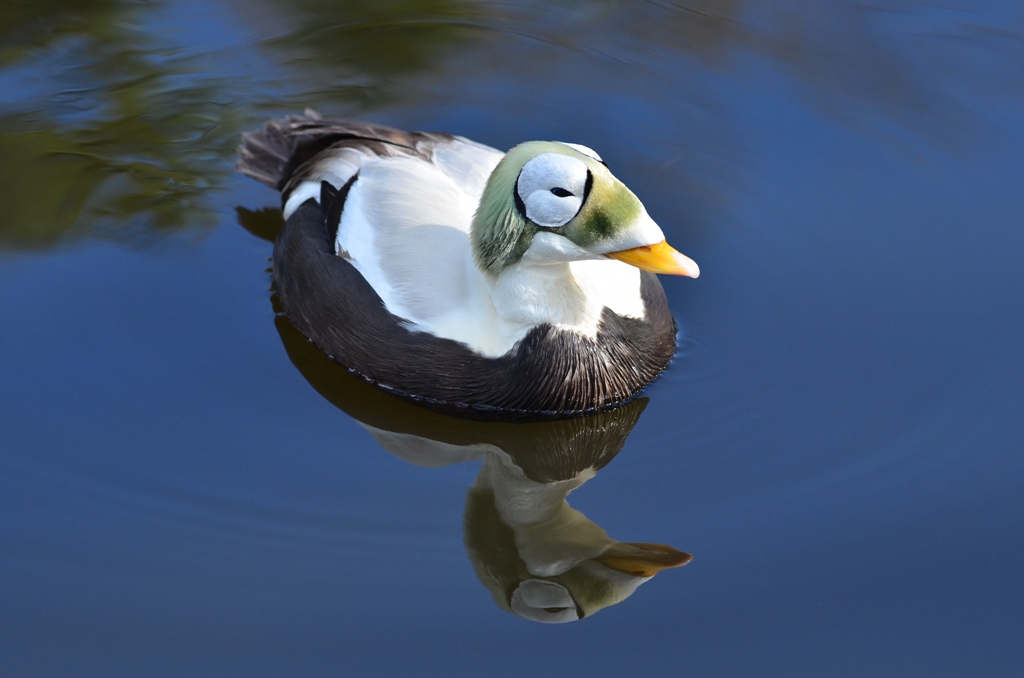
Spectacled eider(Somateria fischeri)
Phylum —chordata
Class — aves
Order — anseriformes
Family — anatidae
Genus –somateria
Appearance
These ducks are sexually dimorphic. With wings folded, the adult male duck is 255-267 mm long, while the female is 240-250 mm. The weight is approximately 1.63 kilograms for males and 1.6 kilograms for females.
The spectacled eider differs from other eiders in that its feathers extend down to the nostrils on the bill. This bill is bright orange on males and blue-gray on females. Both sexes have bright yellow feet. Male eiders, however, have a black chest and pale green head. They are best distinguished by their white patches around the eyes, which are encircled by black feathers to give the appearance of spectacles. Female are drab in comparison. They are brown with black discontinuous streaks and bars of brown. The females also have patches round the eyes, but they are light brown.
Habitat
Currently, spectacled eiders occur along the coast of Alaska and easternmost Russia and into the Bering Sea. There are two breeding populations in Alaska and one in Russia.
Behavior
The spectacled eider migrates to the breeding locations around May and leaves for wintering ground in late July and August. It is not known where the birds migrate to in the winter. The ducks generally fly in groups of two or three or by themselves. When flying, they are close to the surface of the water. In the non-breeding season, they are not found in social groups. They are more social during the breeding season and have been known to form colonies, with the nests very close together.
The spectacled eider is most active during the day, especially in the summer months.
Diet
The ducks are omnivorous. The majority of their diet includes mollusks, such as Razor clams. They also feed on terrestrial and freshwater plant material.
Reproduction
Breeding generally occurs on the Alaskan coast and in northeastern Siberia. Pair bonds form at the beginning of each breeding season, during which there is constant contact between members of a pair. These bonds break immediately after the breeding season is over.
To initiate breeding, females perform inciting movements and calls. Males respond by performing ritualized displays that include exposing the blackened chest.
Nesting occurs in the grass flats or on the periphery of tundra ponds. The nest is built by the female and is lined with grass stems and a large amount of down. Once eggs are laid, the female is very protective of the nest and will often be extremely hesitant to leave, even allowing people to touch her. Clutch sizes average 4.5 eggs and range in number from one to eight. An egg is laid every other day. Incubation lasts for approximately 24 days while the fledging period lasts for 53 days. Drakes are able to mate when they are two years old.
The spectacled eider has a lifespan up to 15 years.
Incaptivity
Eiders live and breed only in the wild. However, people have learned to interact with this bird, mainly to get valuable down, which eiders line their nests.
Every year, expeditions are sent to the breeding grounds of the eiders. Fluff collectors look for birds ' nests and carefully collect fluff. This can be done only before the chicks appear or after they leave the nest. The down in the nest is replaced by hay. The bird calmly returns to the nest after such a replacement and continues to hatch eggs.
 Russian
Russian
 English
English
























